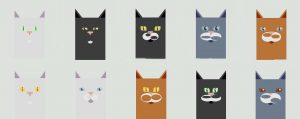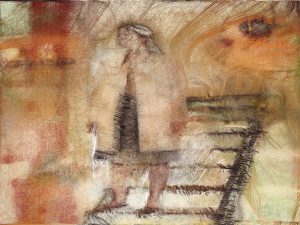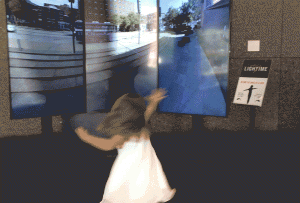//Rebecca Groves
//Section B
//rgroves@andrew.cmu.edu
//Week 02 Variable Face
//color of fur
var reds = [60, 110, 184, 220];
var r = 60;
var b = 60;
var g = 60;
//color of chin
var chinvariables = [1, 2, 3, 4, 5];
var v = 1;
//color of eyes
var eyereds = [210, 194, 253, 147, 152];
var eyer = 210;
var eyeb = 203;
var eyeg = 91;
//size of eyes
var eyeseperation = 230;
var eyewidth = 60;
var eyeheight = 45;
var pupilwidth = 10;
var eyecurve = 30
//size of nose
var nosemultiplier = 1;
var jowelwidth = 90;
var jowelheight = 75;
//right mustache
var rtop = 365;
var rbottom = 400;
var rlength = 70;
//left mustache
var ltop = 340;
var lbottom = 370;
var llength = 50;
function setup() {
createCanvas(600, 600);
background(222,226,222);
}
function draw() {
//headshape
noStroke();
fill(r, b, g);
if (r == 60){
b = 60;
g = 60;
} else // blue grey
if (r == 110){
b = 124;
g = 138;
} else // orange
if (r == 184){
b = 115;
g = 55;
} else
if (r == 220){
b = 220;
g = 220;
}
beginShape();
vertex(150, 600);
vertex(150, 90);
vertex(220, 180);
vertex(600 - 220, 180);
vertex(600 - 150, 90);
vertex(600 - 150, 600);
endShape();
//eyes
ellipseMode(CENTER);
fill(eyer, eyeb, eyeg);
if (eyer == 210){ // yellow green
eyeb = 203;
eyeg = 91;
} else // turquoise
if (eyer == 194){
eyeb = 248;
eyeg = 182;
} else // yellow
if (eyer == 253){
eyeb = 212;
eyeg = 37;
} else // brown
if (eyer == 147){
eyeb = 66;
eyeg = 38;
} else // blue
if (eyer == 152){
eyeb = 186;
eyeg = 205;
}
rectMode(CENTER);
rect(eyeseperation, 290, eyewidth, eyeheight, 0, eyecurve, 0, eyecurve);
rect(600- eyeseperation, 290, eyewidth, eyeheight, eyecurve, 0, eyecurve, 0);
//pupils
fill(60);
ellipse(eyeseperation, 290, pupilwidth, eyeheight);
ellipse(600 - eyeseperation, 290, pupilwidth, eyeheight);
//eye highlight
fill(220);
ellipse(eyeseperation + 10, 290 - (eyeheight * .15), 20, 15);
ellipse(600 - eyeseperation + 10, 290 - (eyeheight * .15), 20, 15)
//ears
noStroke();
fill(r - 50, b - 70, g - 50);
triangle(150, 90 + 20, 220 - 20, 180, 150, 180);
triangle(600 - 150, 90 + 20, 600 - (220 - 20), 180, 600 - 150, 180);
//chin
if (v == 4) { //make chin occasionally white
fill(230);
ellipse(300, 370 + (jowelheight * .4), 55, 55);
} else {
fill(r - 50, b - 70, g - 50);
ellipse(300, 370 + (jowelheight * .4), 55, 55);
}
//jowels
if (v == 4) { //make jowels occasionally solid
fill(r, b, g);
ellipse(300 - 35, 370, jowelwidth, jowelheight);
ellipse(300 + 35, 370, jowelwidth, jowelheight);
} else {
fill(230);
ellipse(300 - 35, 370, jowelwidth, jowelheight);
ellipse(300 + 35, 370, jowelwidth, jowelheight);
}
//left mustache
noStroke();
fill(r, b, g);
ellipseMode(CORNERS);
ellipse(300, ltop, 300 - llength, lbottom);
//right mustache
ellipse(300, rtop, 300 + rlength, rbottom);
//nose
fill(211, 177, 160);
rect(300, 325, 50 * nosemultiplier, 15 * nosemultiplier, 5);
triangle(300 - (20 * nosemultiplier), 320, 300 + (20 * nosemultiplier), 320, 300, 300 + (50 * nosemultiplier));
strokeWeight(3);
stroke(156, 102, 81);
line(300, 300 + (50 * nosemultiplier), 300, 335)
}
function mousePressed(){
reds = [60, 110, 184, 220];
r = random(reds);
eyereds = [210, 194, 253, 147, 152];
eyer = random(eyereds);
chinvariables = [1, 2, 3, 4, 5];
v = random(chinvariables);
eyeseperation = random(210, 260);
eyewidth = random(45, 70);
eyeheight = random(20, 50);
pupilwidth = random(5, 20);
eyecurve = random(20, 50);
nosemultiplier = random(.75, 1.25);
jowelwidth = random(70, 140);
jowelheight = random(65, 110);
rtop = random(370, 370 - (jowelheight * .5));
ltop = random(370, 370 - (jowelheight * .5));
rbottom = rtop + random(20, 70);
while (rbottom > (370 + (jowelheight * .5))){
rbottom = rtop + random(20, 70);
}
lbottom = ltop + random(20, 70);
while (lbottom > (370 + (jowelheight * .5))){
lbottom = ltop + random(20, 70);
}
rlength = (30, jowelwidth - 40);
llength = (30, jowelwidth - 40);
}For this project I was inspired by my childhood cats. They were both tuxedo cats, and most people could only tell them apart by the markings around their mouths – one had a little black mustache and one had a white chin. Here are pictures of them:

1/5 of the time it generates a cat with a solid color face and a white chin and 4/5 of the time it generates a cat with a uniquely shaped mustache. The fur color, eye color and shape, and nose size also change.

![[OLD FALL 2017] 15-104 • Introduction to Computing for Creative Practice](../../../../wp-content/uploads/2020/08/stop-banner.png)



